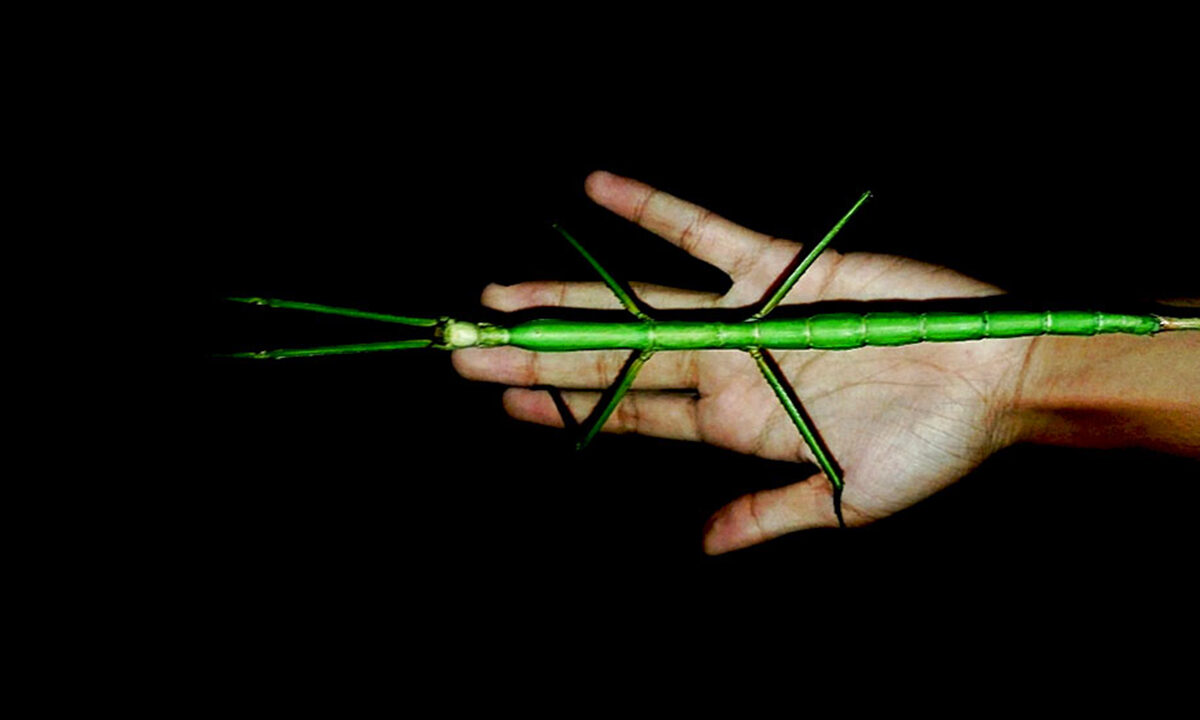- In March 2021, a 14-year-old boy discovered a new species of stick insect on Indonesia’s Timor Island while hiking with his father.
- Two years later, scientists published the first description of the new species in the March 2023 edition of the journal Faunitaxys.
- Davis Marthin Damaledo, now 17, a co-author on the paper, named the foot-long stick insect after a 19th-century king who ruled over his native Timor.
KUPANG, Indonesia — In March 2021, Davis Marthin Damaledo set out on foot accompanied by his father, Dantje, to pursue his childhood fascination with the natural world around his home in eastern Indonesia. As the father and son made progress through the countryside near Oemasi village, in the west of Timor Island, 14-year-old Davis was grateful to have a companion.
“The location was quite far away,” Davis, now aged 17, told Mongabay Indonesia. “If I was by myself, I’d have just searched near home.”
As the pair walked further into the interior, Davis came across a creature that looked unusual to him.
In March last year, Frank H. Hennemann, an associate researcher at Canada’s Montréal Insectarium, together with colleagues from the American Museum of Natural History and City University of New York, published the findings of Davis’s exploration from that day in the journal Faunitaxys.
“The new stick insect Nesiophasma sobesonbaii n. sp. from the island of Timor is described and illustrated from both sexes and eggs,” the authors noted. “It is the first species of the genus Nesiophasma Günther, 1934 to be recorded from Timor and the second species of Phasmatodea known from the island.”

Stick to the plan
Davis decided to gently collect the unknown insect to make further inquiries. On returning home, he contacted Garda Bagus Damastra, founder of the Indonesian Mantis and Phasmid Forum (IMPF), a science collective with around 3,600 members.
Garda’s own story mirrors that of Davis: In 2016, he found a leaf insect that looked similar to another known species, except for unusual patches of purple. A 2020 paper would go on to describe the leaf insect as a new-to-science species, and named it in honor of its discoverer: Phyllium gardabagusi.
Now with Davis reaching out to him, armed with live insect specimens as well as eggs, Garda tapped his research and entomology contacts abroad: Hennemann, Royce T. Cumming, and Stéphane Le Tirant.
The group then went to work, waiting for the eggs to hatch and observing over time the development of the insects until maturity.
“Every phase of the growth was monitored by Davis,” Garda told Mongabay Indonesia in January.
N. sobesonbaii is only the second distinct phasmid species to be recorded from Timor Island. The female’s body size reaches around 20-35 centimeters (8-14 inches).
Davis said he and the foreign scientists chose the name Nesiophasma sobesonbaii in honor of Sobe Sonbaii III, the last ruler of the Sonbai Besar kingdom, which fought the Dutch colonial forces in Timor for much of the 19th century.
Davis’s novel discovery is expected to live across the entire island of Timor, which is politically divided between Indonesia in the west and the independent nation of Timor-Leste in the east.
“Other species are likely to occur throughout Timor and certainly await discovery once more detailed investigations of the Island’s vegetation and different ecozones have been conducted,” the researchers concluded.


Sticks and stones
Davis said that as a child some of his schoolmates found his fascination in insects to border on the strange.
For the IMPF’s Garda, who is also credited in the March 2023 Faunitaxys publication, Davis’s achievement at just 14 years old is crucial for better understanding our world.
“Public awareness of biological riches must be increased. Furthermore, there are unique flora and fauna that exist only in NTT,” Garda said, referring to East Nusa Tenggara province, which includes Indonesian Timor.
About 1.6 million distinct species of animals and plants have been identified and cataloged to date. Approximately 18,000 previously unidentified species are described every year, according to the U.K.’s Royal Society, the world’s oldest academy of sciences. Unidentified species are estimated to account for around 80% of all species on Earth.
“I am proud that my hobby is useful for science,” Davis said. “Insects are often underestimated.”
Banner image: The length of the newly described stick insect can reach up to 35 cm (14 in). Image by Davis Martin Damaledo.
This story was reported by Mongabay’s Indonesia team and first published here on our Indonesian site on Jan. 19, 2024.
Citations:
Hennemann, F., Damastra, G. B., Damaledo, D. M., Cumming, R. T., & Le Tirant, S. (2023). Nesiophasma sobesonbaii n. sp. – a new giant stick insect from the island of Timor, Indonesia (Insecta: Phasmatodea). Faunitaxys, 11(20), 1-13. doi:10.57800/faunitaxys-11(20)
Cumming, R. T., Bank, S., Le Tirant, S., & Bradler, S. (2020). Notes on the leaf insects of the genus Phyllium of Sumatra and Java, Indonesia, including the description of two new species with purple coxae (Phasmatodea, Phylliidae). ZooKeys, 913, 89-126. doi:10.3897/zookeys.913.49044
